2024 Kawasaki Ninja ZX-6R Review – First Ride

Minor tweaks for one of the last supersports still in the game. But is it enough?
In recent years, what it means to be a supersport motorcycle has gone through a dramatic change. It had to – sales of traditional 600cc supersports have tanked since the Great Recession, and most of the old guard have either stopped selling their 600s in the US, or haven’t updated them in years. Why should they? Instead, we have a smattering of motorcycles with sporty intentions – some with fairings and others without. The only common denominator is they all have engines under 1000cc.
2024 Kawasaki Ninja ZX-6R
Kawasaki's keeping the supersport flame alive with a refresh of its 636cc ZX-6R that includes some styling changes and tweaks to pass the sniffer test. Unfortunately, performance has become a victim in this quest for cleaner emissions.
Editor Score: 78.5%
Engine | 16/20 | Suspension | 12/15 | Transmission | 8/10 |
Brakes | 8.5/10 | Instruments | 4/5 | Ergonomics | 7/10 |
Appearance | 9/10 | Desirability | 7/10 | Value | 7/10 |
Highs
- A refreshing reminder of why supersports used to rule the world
- Stock brakes are surprisingly capable
- TFT display is a big improvement
Sighs
- Engine signs off up top
- Quickshifter lags too much
- Riding position is cramped
Motorcycle.com would like to thank Motorcycle Mechanics Institute | MMI for sponsoring this video.
In a way, it’s ironic that Kawasaki – one of the first to upend the traditional 600cc model all the way back in 2002 with its 636cc ZX-6R – is one of the last stalwarts in the class. Not only is Kawasaki holding out, it’s pushing forward – introducing the “updated” 2024 Ninja ZX-6R.
Why the quotes, you ask? Because the reality is this new ZX-6R isn’t too far removed from the previous “update” released in late 2018 ( which I rode), itself dating back to the 636’s revival in 2013 ( which I also rode). I feel old now after writing those last few sentences and realizing how much time has passed since reviewing those bikes. But if there’s something the passage of time has given me, it’s perspective (and a few gray hairs).
What’s New?
Not a lot, really. The sad truth is that, with a class that’s stagnant at best, what’s the point of performing a major overhaul? As sad as it is, there’s a sense that we should just be happy Kawasaki is continuing the ZX-6R at all. With declining sales compounded with ever-tightening emissions requirements, it’s understandable why Yamaha pulled the R6 out of the lineup entirely and why Suzuki and Honda limited where its 600s are sold.
Still, a model refresh starts (and sometimes ends) with a new look, and that’s the most obvious difference with the 2024 ZX-6R. Viewed from the front profile, the nose of the bike has gone through a redesign to more closely match the look of the ZX-10R, and now the ZX-4RR. It’s tighter, with a reshaped ram-air funnel. The 6R now has LED headlights and turn indicators, and while the middle brother now resembles both its bigger and smaller siblings, the front ends aren’t exactly the same. In case you were thinking about swapping parts over.
As far as visual differences are concerned, two more items stand out. First is the switch to round brake discs – a somewhat significant change after years and years with the petal-type discs. The dual discs up front still measure 310mm and are clamped by radial-mount Nissin four-pot calipers. Though the bikes we tested were not ABS models, Kawasaki has updated the ABS software in the Bosch 9.3MP ABS unit for smoother operation.
The other is the transition from an LCD gauge to a 4.3-inch TFT display. Not only is the TFT more attractive and easier to read, according to Kawasaki, the transition also made it possible to integrate the riding modes to a power level and (non-IMU) traction control setting together. Riding modes, power levels, and traction control aren’t new features of the 6R, but tying them all together to individual riding modes is. Now when you choose between Sport, Road, or Rain, you get a preset power and TC setting. Sport gives you full power and the least TC (level 1), Road gives full power and TC level 2 (the middle setting), and Rain gives low power and the most TC (level 3). A fourth riding mode, Rider, allows you to set TC and power levels individually – though really, I’m not sure why you’d want to, unless you want to turn TC off entirely (which you can’t do in the other three riding modes).
If you were hoping for a breakthrough in the 636cc engine, I have bad news for you – it’s mostly the same. In fact, it probably loses a pony or two since the 2024 engine gets new camshafts with a lower lift profile and a shorter duration compared to the previous model. In exchange, the new 6R produces lower exhaust emissions and passes stricter sniff tests.
Ah, the dreaded E-word. Love it or hate it, the quest for clean air isn’t something to be taken lightly, and it certainly isn’t by the manufacturers. It’s not a sexy topic to talk about, but the only way the manufacturers (not just Kawasaki) can legally put bikes on dealership floors is by passing regulations. The engineering involved to meet those requirements and still achieve the same performance levels is impressive and can't simply be dismissed. It’s also why we’re seeing legacy models get bigger engines – it’s an easy way to meet emissions requirements and deliver performance.
Without a bigger engine to turn to however, the 6R not only relies on new cams to pass the sniffer test, but also a different exhaust layout that includes a noticeably larger exhaust pre-chamber. This also places the O2 sensor slightly upstream, closer to the exhaust ports, for a more efficient read and cleaner burn.
After that, the last notable change with the 2024 ZX-6R is the ability to pair the bike with Kawasaki’s Rideology app to view vehicle info, phone notices, and have the ability to tune general settings. There’s also a riding log that tracks running information and uses GPS to track your route. For track oriented folks, technically this can be used to log your lap times, but unlike the ZX-4RR, the 6R’s software doesn’t include a lap function. You have to go into the app and parcel out your laps manually. An inconvenience, but anyone serious about tracking that kind of stuff is likely going to use a more sophisticated third party system, anyway.
Supersport Magic
The ZX-6R riding experience is a great reminder of why the supersport class was so popular. With a proper supersport chassis and a little over 100 horsepower, it’s a great recipe for fast riding without getting in over your head. These kinds of power levels, at least with today’s chassis and tire technology, strike this perfect blend between performance and pleasure.
You can ride the 6R as hard as you dare, and for the most part, you feel like you’re in control the whole time. When you raise the stakes and jump on a liter-class machine pushing 200-plus horsepower, the world is coming at you at a rate that’s hard to process. Not to mention the physical toll it takes to tame one of those beasts. If it weren’t for the recession and supersport prices going through the roof, I can only imagine how advanced the supersport class would be today.
To refamiliarize ourselves with what supersports can offer, and put the new 6R to the test, we gathered at the Ridge Motorsports Park in Shelton, Washington. A favorite track to many across the country, “The Ridge” as it’s more affectionately known, offers a multitude of challenges including hard braking zones, lots of elevation changes, tight corners, fast corners, and blind corners – basically, it’s a rider’s dream.
Naturally, when at a dream-like racetrack, the plan is to get after it when the green flag drops. For this test, the stock Pirelli Diablo Rosso IV tires were shucked in favor of Pirelli’s Superbike Slicks in the SC1 compound and in the stock sizes (120/70-17 front, 180/55-17 rear) – meaning full-send mode was well and truly activated. However, it didn’t take long to reveal some of the bike’s shortcomings.
The Ridge’s long pit lane allows plenty of space to row through the gears and get up to merging speed, and besides the fact the 6R still doesn’t have an autoblipper to go down gears clutchlessly, the quickshifter for upshifts felt snatchy. The ignition kill times were too long, causing an unnecessary pause in power delivery long after the next gear was already selected. It wasn’t as bad in the higher gears, but it was still evident. Aftermarket tuning could help smooth out the lag, but you’d think after being on the market for this long, this would be dialed out by now. Fortunately, Graves Motorsports, Kawasaki’s authorized tuning house, has a complete autoblipper system for the 6R.
One of the things that makes The Ridge a rider’s track is the elevation changes that lead you up and down into a series of corners. Navigating these sections requires a combination of finesse on the throttle, power from the engine to climb up hills, and feedback from the brakes when descending.
Along with a snatchy upshift, the ZX’s fueling leads to jerky on/off throttle transitions, at least in Sport mode (which is where I spent my time). Despite making an effort to turn the grip as gently as I could, the hit when the power comes in is hard to ignore. On the bright side, compared to other 600s, the torque from the extra 36cc was nice to have pulling out of slow-speed corners.
As far as climbing up hills, as the revs start to climb towards the 15,000 rpm redline (indicated on the tach, anyway), there’s a notable drop in power after about 12,500 rpm – likely a result of the new cam profiles. It’s disappointing to have a few thousand more revs at your disposal that are virtually useless, at least it in the current engine’s configuration. Then again, I suppose that’s better than having 5,000 empty revs before redline when riding the stock (electronically restricted) ZX-4RR…
During my time with the ZX-6R, I quickly learned that riding it involved a series of tradeoffs. Lagging shifts, snatchy low-speed fueling, and an engine that signs off early are certainly not good traits (luckily, these can be cured in the aftermarket), but I was pleasantly surprised with the standard Nissin monoblock radial brakes. There are certain corners that put a high demand on the brakes – not least of which is the first turn leading into the chicane. You’re approaching it in the top of fifth gear, sometimes sixth if you get a good run, and dropping down to second. Shedding a ton of speed quickly is of the highest priority, and though the standard pads don’t have as strong an initial bite as I would like, the braking power never failed to scrub off all the speed I needed while still allowing me to trail the brakes deep into the apex. Lap after lap. That said, steel brake lines would be a big upgrade.
With the speed set, the chassis was put to work. Even though the Showa SFF-BP fork is adjustable for preload compression and rebound, all I needed was to slow the rebound damping two clicks to get it where I liked it. Since the front would stay low on corner entry and hold its line through the corner and on the way out, I didn’t have a need to change anything.
Even the rear of the bike felt mostly spot-on. Granted, Kawasaki test riders estimated where the settings should be beforehand. And they were right. However, with the standard 180/55 rear tire, transitions from side to side are a little on the slow side, requiring a little muscle to achieve. This is one of the reasons the reputable tire companies making slicks offer sizing with bigger contact patches and/or aspect ratios – to pitch the bike on its nose a little more and make transitions easier.
Without that option, Kawasaki’s solution was to add a 2mm shim to the shock to achieve the same result. With all other settings being left alone, the shim made a noticeable difference getting the bike to turn. Then, once on its side, the lateral flex from the chassis gives enough feedback to allow the brave – or those looking for social media points (myself included) to dip their elbow on the ground. Considering their relatively budget nature, the Showa suspension is easily capable of going fast right out of the box. The chassis doesn’t communicate as precisely or accurately as more expensive bikes out there, but that’s picking an awfully small nit. Ironically, I still consider the ZX-6R chassis circa 2007 one of the best chassis I’ve ridden. But I digress…
One unexpected nicety I discovered was the shape of the fuel tank allowed me to comfortably place my outside leg on it to brace and support myself as needed. That was especially handy when using my lower body and my core to pick the bike up off a corner or for transitions.
Unfortunately though, that’s where the praise for the ergos stops. The rider triangle is far too narrow to comfortably get into a tuck – which is saying a lot coming from a shorty like me who’s 5-foot, 8-inches tall. The rider pocket is too cramped, and I couldn’t scoot far enough back in the seat, which ends up making my profile wider, in the flow of air, because my elbows are beside my thighs instead of in front of my knees – where they are better protected from the wind – when trying to crouch into a tuck.
The ZX-6R Isn’t The Supersport Savior
While it’s certainly fun, the ZX-6R is starting to show its age – which is especially bad considering what some of Kawasaki’s European competition is bringing to the table. Long gone are the days of complete model refreshes every two years, which was never sustainable anyway. Clearly, considering the ZX-6R is still capable of winning races, as evidenced by Stefano Mesa’s victory at the MotoAmerica round in Pittsburgh recently, the aftermarket (Chuck Graves, specifically) can bring the platform up to a high level. But in stock form, it leaves some to be desired. On the one hand, I’m glad the ZX-6R is still around since it’s always nice to have options. I was just hoping it would be… more.
The 2024 Kawasaki ZX-6R will be available in three colors: Pearl Robotic White/Metallic Graphite Gray, Metallic Flat Spark Black/Ebony, and the KRT Edition with the classic Kawasaki green. All three have the same price: $11,299 for non-ABS models and $12,299 equipped with ABS.
Troy's Gear
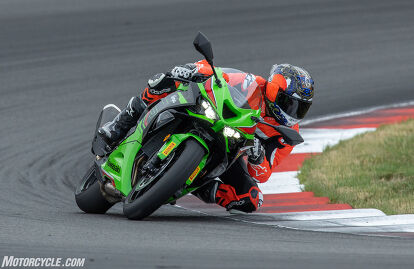
- Helmet: Arai Corsair X Shogun
- Suit: Alpinestars GP Plus v4
- Airbag: Alpinestars Tech-Air 5
- Gloves: Racer Hi-Per
- Boots: Alpinestars Supertech R
2024 Kawasaki Ninja ZX-6R Specifications | |
|---|---|
Engine Type | 4-stroke, In-Line Four, liquid-cooled |
Displacement | 636cc |
Bore x Stroke | 67.0 x 45.1mm |
Valve Train | DOHC; 16-valves |
Compression Ratio | 12.9:1 |
Lubrication System | Wet sump |
Clutch Type | Wet, Multiple Disc |
Starter System | Electric |
Transmission System | Constant Mesh, 6-speed |
Final Transmission | Chain |
Fuel System | DFI w/38mm Keihin throttle bodies (4) and oval sub-throttles |
Frame | Aluminum perimeter |
Rake | 23.5° |
Trail | 4.0 inches |
Front Suspension | 41mm inverted fork (SFF-BP) with rebound and compression damping and spring preload adjustability, and top-out springs /4.7 in |
Rear Suspension | Bottom-link Uni-Trak with gas-charged shock with piggyback reservoir, compression and rebound damping and spring preload adjustability/5.9 in |
Front Brake | Dual semi-floating 310mm discs with dual radial-mounted, monobloc, opposed 4-piston caliper, Kawasaki Intelligent anti-lock Brake System (KIBS) (ABS only) |
Rear Brake | Single 220mm petal discs with single-piston caliper, Kawasaki Intelligent anti-lock Brake System (KIBS) (ABS only) |
Front Tire | 120/70 ZR17 |
Rear Tire | 180/55 ZR17 |
Seat Height | 32.7 inches |
Wheelbase | 55.1 inches |
Curb Weight | 436.6 lb* (ABS), 432.2 lb* (non-ABS) |
Fuel Tank Capacity | 4.5 gal |
Warranty | 12 Month Limited Warranty |
We are committed to finding, researching, and recommending the best products. We earn commissions from purchases you make using the retail links in our product reviews. Learn more about how this works.
Become a Motorcycle.com insider. Get the latest motorcycle news first by subscribing to our newsletter here.

Troy's been riding motorcycles and writing about them since 2006, getting his start at Rider Magazine. From there, he moved to Sport Rider Magazine before finally landing at Motorcycle.com in 2011. A lifelong gearhead who didn't fully immerse himself in motorcycles until his teenage years, Troy's interests have always been in technology, performance, and going fast. Naturally, racing was the perfect avenue to combine all three. Troy has been racing nearly as long as he's been riding and has competed at the AMA national level. He's also won multiple club races throughout the country, culminating in a Utah Sport Bike Association championship in 2011. He has been invited as a guest instructor for the Yamaha Champions Riding School, and when he's not out riding, he's either wrenching on bikes or watching MotoGP.
More by Troy Siahaan



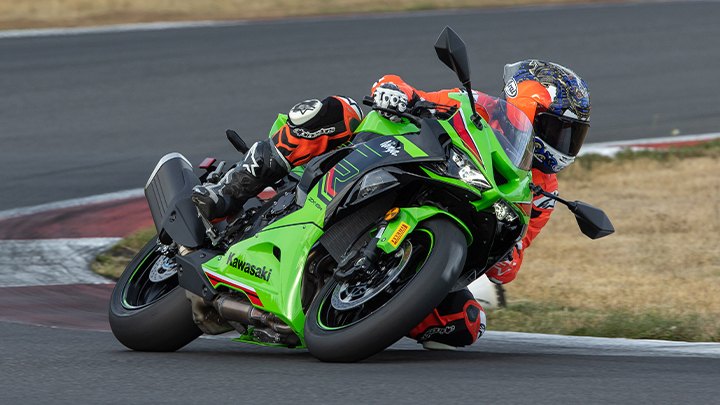























































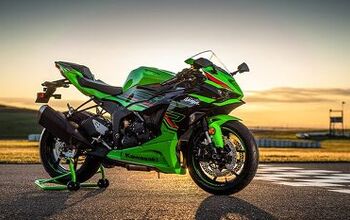
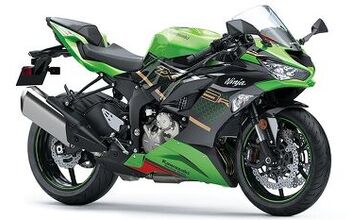

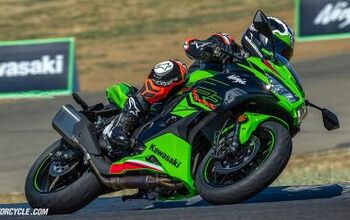













Comments
Join the conversation
A lightweight, snappy bike is a good thing to see, even if the ergonomics sound like it better suits jockeys.
It feels like a vicious circle consumed the 600 class, where the bikes became less of an all-rounder to win races, and then the racing ergos took away from the all-rounder aspects of the class.
I have fond memories of my year 2001 ZX-6R, which was a commuter, track bike and tourer for me.
Although it should be entirely unrelated, I now own a white 2015 Panigale 899. The look of the white version of the 2024 ZX-6R is curiously familiar to me....
My first mc was a honda 90.....can't remember model yr. Fun to learn on.
Worked thru a couple of suzukis. Last bikes were kawis: 1600 and 650. Super reliable, lots of fun.
I'm 75 now, off bikes since c. 2018. My Calif driver license an i.d. card. I dont drive a car, either, due to some memory loss, and walk with a cane becuz of botched left foot surgery. frau of 53 yrs does all the driving. She's good at it 😉
Later, 'gators! 😄😁😆😅